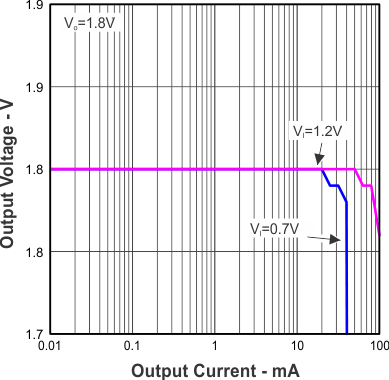-
TLV61220 Low-Input Voltage Step-Up Converter in Thin SOT-23 Package
- 1 Features
- 2 Applications
- 3 Description
- 4 Typical Application Schematic
- 5 Revision History
- 6 Device Options
- 7 Pin Configuration and Functions
- 8 Specifications
- 9 Parameter Measurement Information
- 10Detailed Description
- 11Application and Implementation
- 12Power Supply Recommendations
- 13Layout
- 14Device and Documentation Support
- 15Mechanical, Packaging, and Orderable Information
- IMPORTANT NOTICE
TLV61220 Low-Input Voltage Step-Up Converter in Thin SOT-23 Package
1 Features
- Up to 95% Efficiency at Typical Operating Conditions
- 5.5-μA Quiescent Current
- Startup Into Load at 0.7-V Input Voltage
- Operating Input Voltage from 0.7 V to 5.5 V
- Pass-Through Function during Shutdown
- Minimum Switching Current 200 mA
- Protections:
- Output Overvoltage
- Overtemperature
- Input Undervoltage Lockout
- Adjustable Output Voltage from 1.8 V to 5.5 V
- Small 6-pin Thin SOT-23 Package
2 Applications
- Battery Powered Applications
- 1 to 3 Cell Alkaline, NiCd or NiMH
- 1 Cell Li-Ion or Li-Primary
- Solar or Fuel Cell Powered Applications
- Consumer and Portable Medical Products
- Personal Care Products
- White or Status LEDs
- Smartphones
3 Description
The TLV61220 device provides a power-supply solution for products powered by either a single-cell, two-cell, or three-cell alkaline, NiCd or NiMH, or one-cell Li-Ion or Li-polymer battery. Possible output currents depend on the input-to-output voltage ratio. The boost converter is based on a hysteretic controller topology using synchronous rectification to obtain maximum efficiency at minimal quiescent currents. The output voltage of the adjustable version can be programmed by an external resistor divider, or is set internally to a fixed output voltage. The converter can be switched off by a featured enable pin. While being switched off, battery drain is minimized. The device is packaged in a 6-pin thin SOT-23 package (DBV).
spacer
Device Information(1)
| PART NUMBER | PACKAGE | BODY SIZE (NOM) |
|---|---|---|
| TLV61220 | SOT (6) | 2.90 mm x 1.60 mm |
- For all available packages, see the orderable addendum at the end of the datasheet.
4 Typical Application Schematic
![TLV61220 TLV61220 pmi_schem776rev7[1].gif](/ods/images/SLVSB53A/pmi_schem776rev7[1].gif)
5 Revision History
Changes from * Revision (May 2012) to A Revision
- Added ESD Ratings table, Feature Description section, Device Functional Modes, Application and Implementation section, Power Supply Recommendations section, Layout section, Device and Documentation Support section, and Mechanical, Packaging, and Orderable Information sectionGo
6 Device Options
| TA | OUTPUT VOLTAGE DC/DC |
PACKAGE | PART NUMBER |
|---|---|---|---|
| –40°C to 85°C | Adjustable | 6-Pin SOT-23 | TLV61220DBV |
7 Pin Configuration and Functions

Pin Functions
| PIN | I/O | DESCRIPTION | |
|---|---|---|---|
| NAME | NO. | ||
| EN | 3 | I | Enable input (VBAT enabled, GND disabled) |
| FB | 4 | I | Voltage feedback for programming the output voltage |
| GND | 2 | — | IC ground connection for logic and power |
| SW | 1 | I | Boost and rectifying switch input |
| VBAT | 6 | I | Supply voltage |
| VOUT | 5 | O | Boost converter output |
8 Specifications
8.1 Absolute Maximum Ratings
over operating free-air temperature range (unless otherwise noted) (1)| MIN | MAX | UNIT | ||
|---|---|---|---|---|
| VIN | Input voltage on VBAT, SW, VOUT, EN, FB | –0.3 | 7.5 | V |
| TJ | Operating junction temperature | –40 | 150 | °C |
| Tstg | Storage temperature | –65 | 150 | °C |
8.2 ESD Ratings
| VALUE | UNIT | |||
|---|---|---|---|---|
| V(ESD) | Electrostatic discharge | Human-body model (HBM), per ANSI/ESDA/JEDEC JS-001(1) | ±2000 | V |
| Charged-device model (CDM), per JEDEC specification JESD22-C101(2) | ±1500 | |||
8.3 Recommended Operating Conditions
| MIN | NOM | MAX | UNIT | ||
|---|---|---|---|---|---|
| VIN | Supply voltage at VIN | 0.7 | 5.5 | V | |
| TA | Operating free air temperature range | –40 | 85 | °C | |
| TJ | Operating virtual junction temperature range | –40 | 125 | °C | |
8.4 Thermal Information
| THERMAL METRIC(1) | TLV61220 | UNIT | |
|---|---|---|---|
| DBV | |||
| 6 PINS | |||
| RθJA | Junction-to-ambient thermal resistance | 185.7 | °C/W |
| RθJC(top) | Junction-to-case (top) thermal resistance | 124.3 | |
| RθJB | Junction-to-board thermal resistance | 31.3 | |
| ψJT | Junction-to-top characterization parameter | 22.9 | |
| ψJB | Junction-to-board characterization parameter | 30.8 | |
| RθJC(bot) | Junction-to-case (bottom) thermal resistance | N/A | |
8.5 Electrical Characteristics
over recommended free-air temperature range and over recommended input voltage range (typical at an ambient temperature range of 25°C) (unless otherwise noted)| PARAMETER | TEST CONDITIONS | MIN | TYP | MAX | UNIT | ||
|---|---|---|---|---|---|---|---|
| DC/DC STAGE | |||||||
| VIN | Input voltage range | 0.7 | 5.5 | V | |||
| VIN | Minimum input voltage at startup | RLoad ≥ 150 Ω | 0.7 | V | |||
| VOUT | TLV61220 output voltage range | VIN < VOUT | 1.8 | 5.5 | V | ||
| VFB | TLV61220 feedback voltage | 483 | 500 | 513 | mV | ||
| ILH | Inductor current ripple | 200 | mA | ||||
| ISW | switch current limit | VOUT = 3.3 V, VIN = 1.2 V, TA = 25 °C | 220 | 400 | mA | ||
| VOUT = 3.3 V, TA = -40°C to 85 °C | 180 | 400 | mA | ||||
| VOUT = 3.3 V, TA = 0°C to 85 °C | 200 | 400 | mA | ||||
| RDS(on) | Rectifying switch on resistance, HSD | VOUT = 3.3 V | 1000 | mΩ | |||
| VOUT = 5 V | 700 | mΩ | |||||
| Main switch on resistance, LSD | VOUT = 3.3 V | 600 | mΩ | ||||
| VOUT = 5 V | 550 | mΩ | |||||
| Line regulation | VIN < VOUT | 0.5% | |||||
| Load regulation | VIN < VOUT | 0.5% | |||||
| IQ | Quiescent current | VIN | IO = 0 mA, VEN = VIN = 1.2 V, VOUT = 3.3 V |
0.5 | 0.9 | μA | |
| VOUT | 5 | 7.5 | μA | ||||
| ISD | Shutdown current | VIN | VEN = 0 V, VIN = 1.2 V, VOUT ≥ VIN | 0.2 | 0.5 | μA | |
| ILKG | Leakage current into VOUT | VEN = 0 V, VIN = 1.2 V, VOUT = 3.3 V | 1 | μA | |||
| Leakage current into SW | VEN = 0 V, VIN = 1.2 V, VSW = 1.2 V, VOUT ≥ VIN | 0.01 | 0.2 | μA | |||
| IFB | TLV61220 Feedback input current | VFB = 0.5 V | 0.01 | μA | |||
| IEN | EN input current | Clamped on GND or VIN (VIN < 1.5 V) | 0.005 | 0.1 | μA | ||
| CONTROL STAGE | |||||||
| VIL | EN input low voltage | VIN ≤ 1.5 V | 0.2 × VIN | V | |||
| VIH | EN input high voltage | VIN ≤ 1.5 V | 0.8 × VIN | V | |||
| VIL | EN input low voltage | 5 V > VIN > 1.5 V | 0.4 | V | |||
| VIH | EN input high voltage | 5 V > VIN > 1.5 V | 1.2 | V | |||
| VUVLO | Undervoltage lockout threshold for turn off | VIN decreasing | 0.5 | 0.7 | V | ||
| Overvoltage protection threshold | 5.5 | 7.5 | V | ||||
| Overtemperature protection | 140 | °C | |||||
| Overtemperature hysteresis | 20 | °C | |||||
8.6 Typical Characteristics
Table 1. Table of Graphs
| FIGURE | ||
|---|---|---|
| Output Current | Input Voltage, ISW = 330 mA, Minimum ISW= 200 mA, VO = 1.8V | Figure 1 |
| Input Voltage, ISW = 400 mA, Minimum ISW = 200 mA, VO = 3.3V | Figure 2 | |
| Input Voltage, ISW = 380 mA, Minimum ISW = 200 mA, VO = 5V | Figure 3 | |
| Efficiency | vs Output Current, VO = 1.8 V, VI = [0.7 V; 1.2 V; 1.5 V] | Figure 4 |
| vs Output Current, VO = 3.3 V, VI = [0.7 V; 1.2 V; 2.4V; 3V] | Figure 5 | |
| vs Output Current, VO = 5 V, VI = [0.7 V; 1.2 V; 3.6V; 4.2V] | Figure 6 | |
| Efficiency | vs Input Voltage, VO = 1.8 V, IO = [100µA; 1mA ; 10mA; 50mA] | Figure 7 |
| vs Input Voltage, VO = 3.3 V, IO = [100µA; 1mA ; 10mA; 50mA] | Figure 8 | |
| vs Input Voltage, VO = 5 V, IO = [100µA; 1mA ; 10mA; 50mA] | Figure 9 | |
| Output Voltage | vs Output Current, VO = 1.8 V, VI = [0.7 V; 1.2 V] | Figure 10 |
| vs Output Current, VO = 3.3 V, VI = [0.7 V; 1.2 V; 2.4 V] | Figure 11 |
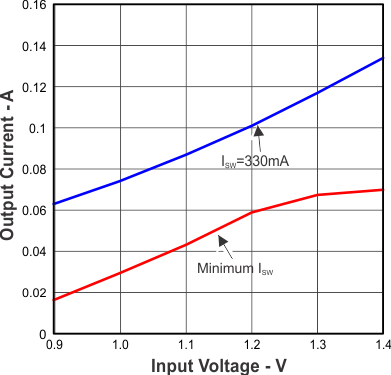
| VO = 1.8 V |

| VO = 5 V |

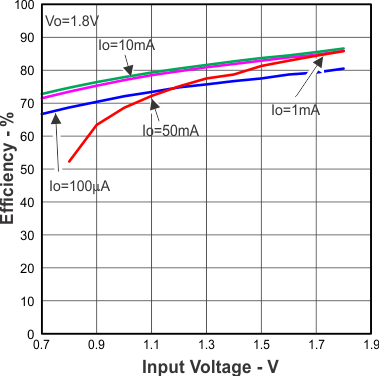
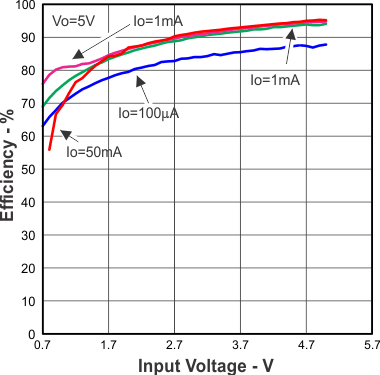
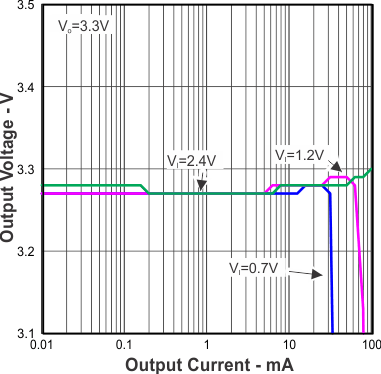

| VO = 3.3 V |



